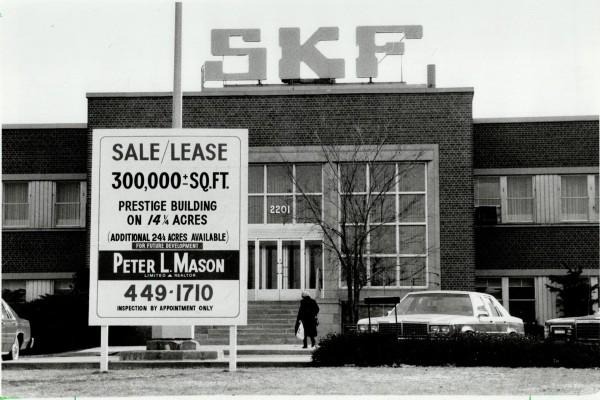The Americanization of CN
An American funeral for the demise of a Canadian institution

Photo by Gareth Bayer/Flickr
The CN rail strike
It is day 16 of the strike at Symington Yard, the Canadian National Railway’s main hump yard in Winnipeg. It is a cold, gray, and dank day. The wind is blowing. The sound of cars from the nearby street swishes by. The workers talk amongst themselves. Strapped to the outside of their bulky winter coats are signs with the word “STRIKE” printed boldly in large letters. Sympathetic cars passing by honk their horns, and the workers nearest the street raise their hands in response to the expressions of solidarity.
Guy Bouvier, a CN employee walking the picket line, peers from the shell of his winter coat. Even though the sun is nowhere to be seen, he wears a pair of fluorescent sunglasses that would not be out of place on a ski hill.
“I hired on in ’81. There were approximately 76,000 people working at that time. In 1967 there were about 125,000 people. Right now we’re down to eighteen-five,” says Bouvier.
Behind him, a group of his fellow workers and members of the Canadian Auto Workers union (CAW) huddle by a burning barrel located on the perimeter of the yard. A couple of them throw pieces of scrap lumber into it. Sparks fly up, but are quickly blown out by the brisk, chill Manitoba wind. Nearby, a City of Winnipeg police caravan sits silently, watching over the entrance to Symington Yard like a bulbous metal spider.
The workers have been on strike since February 20, when an initial offer from CN was scrapped. But since a deal has by now been reached, the question is why CN rail workers from Winnipeg to Montréal felt it was time to send a message to CN’s corporate headquarters.
The privatization of the CNR
Canadian National was born out of a series of smaller rail lines that, after running out of funds, were then bought by Robert Borden’s Conservative government back in 1918. The political machinations and motivations behind the nationalization of the Canadian railways were complex. Aside from rescuing the banks–the creditors of the bankrupt rail companies–a government-owned national railway system would be better able to provide cheaper rates for businesses that wanted to distribute their goods as efficiently as possible than would a privately-owned monopoly–which was the threat that the Montréal-based Canadian Pacific Railway posed to the Toronto business community at the time. After the dust settled and the Canadian government put its stamp on all the rail lines in Canada–over 22,000 miles of track and 100,000 employees–CN had became one of the world’s largest railroads.
“To put it in a historical perspective, CN was the flagship, premier Crown corporation of this country,” says Robert Bourrier, a CAW system health-and-safety legislative representative and CN history buff. “Out of it came TCA [TransCanada Air Lines, the forerunner of Air Canada] and the CBC.”
CN, however, almost always operated in the red, and it was rare that it showed a profit. In the late 1970s, the federal government forgave CN’s loans, which allowed the company to show a modest profit. But by the eighties, with increasing competition from other railroad companies and the trucking industry, there was a movement by some in the federal government to make CN more competitive. Many believe that these moves were taken as the first steps in the eventual privatization of CN.
“In the late eighties there was a big move to deregulate the railway industry under such banners as ‘Freedom to Move,’ ” Bourrier explains. The Railway Safety Act was gutted and other legislative steps were taken to deregulate the railroad industry and bring it ostensibly more in line with the relatively few safety regulations governing the trucking industry. The current rules governing safety are “company-written,” states Bourrier. “[They] were presented by the Railway Association of Canada … the railway companies basically re-wrote the rules,” allowing them “the flexibility to do what they want.”
CN underwent a massive structural change, as well. It divested itself of many of its other businesses, like the Toronto’s CN Tower, in order ostensibly to concentrate fully on the railroad business and to reduce its debt. Advisors also believed CN had overcapacity in certain rail lines that were underutilized and, thus, uncompetitive. This belief led to the closure of rail lines in rural areas, once the sole raison d’être of many a small town. Thousands of miles of rural track were ripped up, leaving nothing but beds of gravel to show where there were once rail lines.
“You have CN shedding those lines that historically were built to service our Canada … and having them spun off into short-line operations … or shut down altogether,” says Bourrier.
The move to make CN competitive eventually led to the conclusion that it would be best if CN were privatized. This was foreshadowed when Paul M. Tellier, a top-level Liberal bureaucrat, became CN’s president and CEO in 1992. “[Tellier’s] mandate, in my opinion, was to privatize CN,” states Bourrier.
Actual privatization happened in 1995, when the federal Liberal government made CN a publicly traded company. “They figured out an approximate value and … sold [CN] off,” says Derek Black, a retired machinist with a 30-year history at the company.
CN’s website claims that the privatization of CN “was the largest and most successful privatization in Canadian history,” selling all the offered shares within a single day, pouring $2.2 billion into the federal government’s coffers.
Canadian in name only?
Around the same time as the privatization of CN, according to Black, laws governing the percentage of foreign ownership changed, allowing for greater foreign investment in Canadian companies.
“The end result was that you had more and more shares ending up in American hands,” Black comments. He estimates that the percentage of American and foreign ownership of CN shares is now between 80 and 90 per cent. “It’s a publicly traded company,” adds CAW national representative Doug Olshewski. “But 80 per cent of the stock is held by Americans.”
CN’s next move was interesting: It purchased Illinois Central, a major American railroad company. Illinois Central is based out of Chicago and runs south to New Orleans. But whether CN really purchased Illinois Central, or if it was the other way around, remains an open question.
The Illinois Central purchase of was just the first manifestation of CN’s newfound thirst for acquisitions. It went on a buying spree, snapping up smaller, class-2 American railroad companies, like Wisconsin Central. The goal was to increase CN’s distribution control over North America by having connections to the three coasts: east, west, south. Black maintains that more was happening at CN than just these acquisitions: there was a re-calibration of management as well. “In order to cement these mergers and purchases, they began a process of integrating the management,” he explains. Tellier was still CEO at the time of the Illinois Central purchase; but the merger with Illinois Central was accompanied by the arrival of E. Hunter Harrison, president and CEO of Illinois Central, who then became Tellier’s number two man. In 2003, Harrison became the chief. Since then, there appear to have been more and more Americans in senior management positions.
In other words, CN was fast losing any connection to its Canadian roots. On the day of CN’s privatization, Black organized a New Orleans-style funeral for CN: a perhaps perverse but fitting American funeral for the demise of a Canadian institution.
Business American style
CN soon started changing its business practices drastically in order to cut costs and boost profits.
“Once it was privatized and out of the control of the federal government, [CN] began a very aggressive campaign of contracting the repair and maintenance work out and shipping it south of the border to little shops and plants in the United States,” Black says. “All of a sudden you find the work disappearing, and you’d have a tough time figuring out where the work had gone.”
Black and his fellow workers also noticed another, sleazier change in CN’s corporate attitude. “They became much more sophisticated in some of the wheeling and dealing going on. There were rules and regulations under the collective agreements that forbade the contractingout of work. [CN] began to, quote-unquote, “scrap” locomotives, and they would sell them to an American firm. The American firm would then move them into Montréa … into a former CN shop. There [the locomotives] would be totally re-built, shipped back to the American firm, and then leased back to Canadian railways.”
Black then chooses his words carefully: “That’s what I would refer to as a really ‘sharp’ practice.”
Black believes that, to those pushing the privatization process, the attraction of privatization itself was more important than looking at the actual costs and value of keeping CN public. “The quality [of repair work by Americans] doesn’t stand up, the price doesn’t stand up. If it was costing $1,000 to do a job in the shop here, then it was costing them $2,000 to get [the job] done in the States.” In other words, saving money wasn’t the point of privatizing CN.
Another questionable business practice on CN’s part happened during the strike, when scab workers were imported from the U.S. to fill Canadian workers’ positions when the latter went on strike. According to Bill Blaikie, Member of Parliament for Transcona, historically a railway workers’ community, this violates a NAFTA provision under which no company is allowed to transfer workers from one country to another. “The [federal] government refused to do anything about it because it said this was an intra-company transfer,” says Blaikie. The federal government, he argues, was “hiding behind NAFTA. But, in fact, there were provisions in NAFTA , if the government were willing to use them … about not being able to bring workers in for the purpose of getting involved in a labour dispute.”
American-style management
Many CN workers believe that with the Americanization of CN came a different, more aggressive attitude to the treatment of workers. “They come from a different culture in the United States in terms of labour relations … in terms of their political [and] social views,” Bourrier explains. He describes the American managers at CN as “ruthless” by Canadian standards. “They have very little regard for Canadian rules. Whatever [rules] don’t suit them, they will try to change them.”
In addition to actively lobbying the Canadian government to change labour laws in its favour, CN has instituted some eyebrow- raising labour changes for the workers of CN themselves. First came an increased workload, which CN workers now must bear owing to the technological advances in the railroad industry and an increased need to maximize profits by lowering costs.
“What we found was that there was so much anger towards the employer that a strike was inevitable,” Olshewski says. “The company’s prime objective was to have the best operating ratio in North America … which means for every 66 cents they spend they earn a dollar. And that meant huge rationalization, speed-ups, productivity gains–all on the backs of the workers.”
Another workers’ grievance related to workplace injury. The old system was a nofault system, and the former CN management treated injuries within that context. In the U.S. system, with its emphasis on personal responsibility and its penchant for lawsuits, the employer is responsible for the workplace. Since it is in the best interest of management to avoid lawsuits, the American management imported the American method of dealing with injuries. Olshewski says the management has no sympathy: “If you get in an accident, it’s your fault.” The unfortunate result is that workers, given the choice between reporting an injury or getting suspended, tend not to report.
But the change in management style that has angered CN workers most involves the issue of discipline. Many CN workers believe they are not respected by CN management, one of the main reasons they voted down an initial contract offer between CN and their union representatives. The fact that their union recommended approval of the offer caused some anger among workers who questioned the union’s commitment.
“We have had a disciplinary policy that has been in effect for a hundred years called the Brown system of discipline, which means you get demerit marks for punishment,” says Olshewski. He says the new management didn’t want to keep the Brown system. “They said it was too hard to fire people under that system …they wanted to change arbitration procedure.”
Bourrier seems to agree that the new CN management took a harder line on discipline, adding that management “was giving suspension for very, very slight infractions.”
“It’s the way people are being treated, the lack of dignity shown to the workers, that has become a real big issue here,” Olshewski says.
Perhaps icing on the cake, Black claims he has heard American managers giving derisive slurs to Canadian CN employees, including names like “snow niggers” and “overpaid Mexicans.”
The strike has ended some time ago. According to the union’s interpretation of what was agreed to, it was a major victory for the workers, with favourable resolutions on safety and discipline issues. Others, like Hunter Harrison, took away a different understanding. The final outcome is still unclear.
Eric Warwaruk was born and raised on a family farm in midwestern Manitoba. He has a degree in film studies from the University of Manitoba, and is completing his MA thesis in communications studies at McGill University in Montréal. He currently works as a freelance writer in Winnipeg.
This article appeared in the May/June 2004 issue of Canadian Dimension .










